

Exploring our past to sort out myth from reality
Share this Page on
Facebook or Twitter

These are the voyages of the TimeShip Anachron.
Our Mission: To boldly explore the past, dispelling
mythinformation and mythconceptions
of American History along the way.
 Visit us on Facebook
Visit us on Facebook
Meet MythAmerica LITE
Woodstic Surgery
Guess Who this Famous Face is…
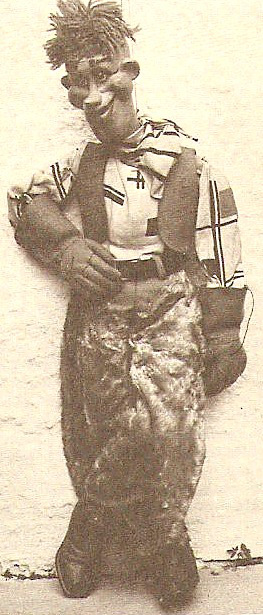
I’m pretty sure I would never have guessed if I hadn’t seen the article on the Web where I found this pic.
This is “the” Howdy Doody. The original one, sidekick of Buffalo Bob (Smith) when the Howdy Doody Show first hit the TV airwaves in 1948.
But wait! I’m a Child of the Fifties. I grew up on Howdy Doody…and that isn’t the Howdy of my dreams of childhood. That’s a nightmare!
And therein lies a story.
The marionette you see in the pic above was designed and constructed by professional puppeteer Frank Paris.
“Buffalo Bob” Smith (who was from Buffalo, NY) had at first been a radio announcer/performer, and he introduced Howdy Doody as a disembodied voice on his NBC radio show. The popularity of the character triggered plans for a TV show in the infancy of Television. So Paris was engaged by the producers to create the star of the show, the strange looking wooden dude you see in the pic above.
The new show took off, and before long a demand developed for Howdy merchandise. Macy’s contacted Paris regarding licensing the right to produce a Howdy doll.
While Paris had created the puppet, it was Bob Smith who owned the rights to the Howdy Doody character; an argument ensued between the two men, as Paris felt he was being cheated out of any financial benefits from having made the puppet. After one such disagreement, Paris took the Howdy Doody puppet and angrily left the NBC studios with it about four hours before the show was to air live; it was not the first time Paris had taken his puppet and left, leaving the live television program with no "star". [Wiki: Howdy Doody]
AARRGGHH! A national “live audience” of kiddies waiting to see their hero, and he’d been puppetnapped! This would not do!
And thus an elaborate backstory was created to cover up the dastardly deed—and provide time for puppeteer Velma Dawson to design and craft a new puppet to take the place of the “original” Howdy. Legal problems precluded making a puppet that was similar to the old one (even if they would have wanted to-
Earlier in the season, the producers had decided that they needed to find out how big the television audience was, so that they could have more leverage to solicit advertisers. Thus they decided to create an ongoing story line that Howdy was running for President. Roger Muir, the show's original producer-
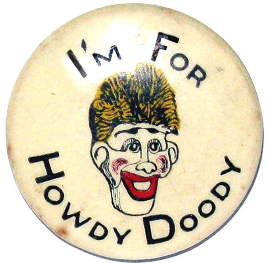
Even in the beginning, whatever Howdy wanted, Howdy got. He wanted children to write in supporting his campaign? He got it. The requests for I'm for Howdy Doody buttons kept coming in.
Two days after the button offer was announced, NBC issued a press release that 6,304 requests have been received. A day later, that figure was revised to 26,000.
Smith told People magazine in 1989: "The response was overwhelming, like 150,000 returns after one mention on the air, and we had only ordered 10,000 buttons. We had no idea it would be that successful, but it turned out everybody was over at the neighbor's house watching The Howdy Doody Show."
Smith estimated that more than 250,000 kids wrote in asking for the button. [All Hail Howdy Doody]
When Howdy was puppetnapped, the presidential campaign was pressed into service as the “excuse” for Howdy to be gone. The show’s script writer, Edward Kean, “sent” Howdy off to the farthest point in the US he could think of, Portland, Oregon, to go on the campaign trail. The show began featuring a large US wall map daily, that would pinpoint where Howdy was that day. He’d then communicate with Buffalo Bob via the “Super Talk-
And early on, he mentioned on air that……
"he had met his handsome rival Mr. X and realized he wouldn't get any votes from girls unless he had plastic surgery.”… "He'd tell us about the hospital, and how he was fine, didn't mind plastic surgery, and knew he'd get the girls' votes now that he'd be handsome too. In other words, we stalled and stalled. "
This appeased the kids, but not the sponsors. They wanted Howdy in the commercials and not just on the Super Talk-
Of course, maybe they shouldn't have called this “plastic surgery.” I'm pretty sure the original Howdy wasn't made of plastic. If he really was a woodenhead, they should have called it…woodstic surgery! In any event, the "surgery" was successful.
The bandages finally came off June 8, 1948, revealing the red-
Here’s Howdy on the show, the fateful moment when he and the world got to see his new face. He declared himself—with his 48 fresh freckles, one for each of the 48 states at the time—suitably handsome.
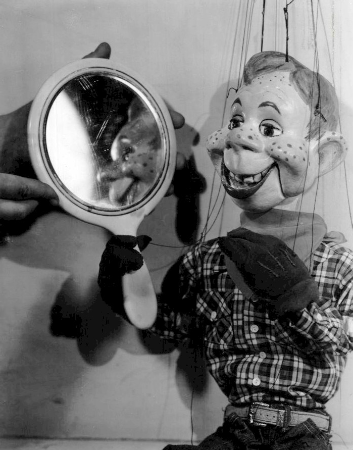
And it worked. Sponsors began to join in Howdy's campaign efforts. Children were invited to vote by filling out a form printed on the end of Wonder Bread bags. Post Cereals included a Howdy Doody for president ring. Like any good politician, Howdy told the children what they wanted to hear, promising two Christmas holidays but just one school day a year and more pictures in history books. Time magazine even took note of the campaign, reporting that Howdy was pushing for free admission to the circus and rodeo. [ibid.]
About that mysterious Mister X he was running against?
The campaign gave Kean the chance to figure out just who the mysterious Mr. X would be. He didn't have a clue. But to keep the mystery going, kids in the peanut gallery were invited to guess what Mr. X might look like. All the children really knew about Mr. X was that, as Buffalo Bob described him, "the handsomest man in the world," and he was opposed to everything Howdy stood for.
Mr. X campaigned that school should be seven days a week, that no child should ever get an ice cream sundae and that comic books should be banned. "His campaign was all negatives," Kean recalled in an interview conducted via e-
Eddie Kean was a very clever script writer, though…
Kean decided who Mr. X was only after seeing the new Howdy Doody, unbandaged at last. He would make Mr. X Howdy's twin brother, Double Doody. The twin was a second marionette created to allow Howdy to make costume changes.
The negative campaign run by Mr. X suddenly became clear. "His awful campaign was to ensure the victory of his brother Howdy and keep other potential candidates out of the picture," Kean said.
Campaign buttons later showed the new handsome Howdy.
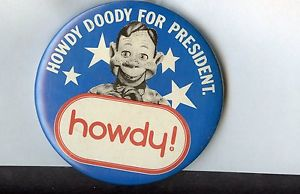
And Mr. X’s nefarious plot worked.
New York Times TV columnist Jack Gould reported in the paper that Howdy beat Mr. X by “a margin of 10,000,000 ballots, more or less.” And thus Howdy came in third overall in the race, behind Truman and Dewey.
Kean's recollection is that Howdy received more than 25 million votes while Mr. X got one. All of those numbers are probably greatly inflated; on a show the week before the election, the Votedoodle reported that so far Mr. X had attracted 64,129 votes while Howdy had received 406,620.
No matter. Howdy couldn't lose the election. With Kean in control, the fix was in. Howdy was inaugurated Jan. 14, 1949, as "President of all the Kids in the United States." He was sworn in by Ben Grauer, announcer for the NBC Symphony Orchestra. [ibid.]
Kean, who was only 23 when he first starting writing for Buffalo Bob, was pretty amazing. In addition to coming up with all the convoluted story line for that particular crisis, he ended up creating and naming almost all the main characters on the show, and he wrote 1,980 scripts (and 99 songs) during the seven years he was with the show, filling five days a week year around with Doodyism. He mentioned in one interview that he never took a rest. When he went on vacation, he took his typewriter with him and continually mailed scripts back for the show.
Although the Howdy Doody show later pulled in big bucks for the network, and the show’s budget no doubt grew accordingly, Buffalo Bob was only given $75 to put on the first episode, and he gave $25 of that to Eddie Kean to write the script.
After the 1948 presidential race, the Howdy Doody show remained a fixture on children’s TV until 1960. Lots o’ memories for anyone who grew up in the Cold War era.
Although the emphasis later was on a “western” theme, with Howdy and Bob dressed as cowpokes, originally the show had a circus theme, with Bob looking like a ringmaster.
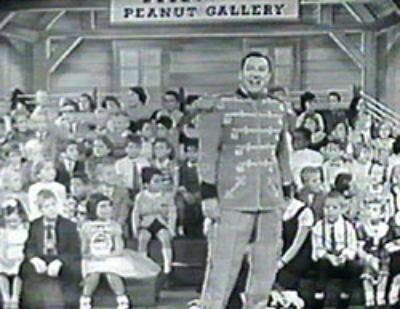
he kids crowded into the little “grandstand” in the background were called the Peanut Gallery.
A peanut gallery was, in the days of vaudeville, a nickname for the cheapest (and ostensibly rowdiest) seats in the theater, the occupants of which were often known to heckle.
The least expensive snack served at the theater would often be peanuts, which the patrons would sometimes throw at the performers on stage to show their disapproval. The phrases "no comments from the peanut gallery" or "quiet in the peanut gallery" are extensions of the name, meaning the commoner should defer to their betters.
In the late 1940s the Howdy Doody children's television show adopted the name to represent its audience of children. [Wiki: Peanut gallery]
This original theme no doubt contributed to the decision to include a clown…Clarabell the Clown.
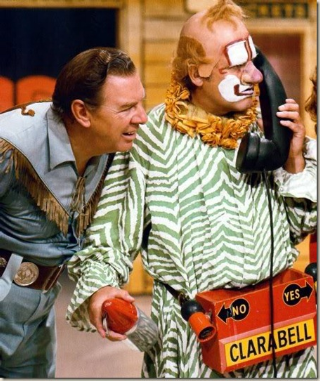
Clarabell never talked. He just honked the bicycle horns mounted on his belt box to communicate, once for "No" and twice for "Yes." And much of the rest of the time, he randomly chased Buffalo Bob and others around the set, squirting them with a seltzer bottle.
Smith pulled some of his radio helpers over to the television studio. A former NBC page named Bob Keeshan, who was keeping busy running to the New York Public Library to look up historical facts for Smith, came along as an assistant. He handed out prizes. Outfitted in a sportscoat, Keeshan didn't fit in with the circus theme, so he was costumed as a silent clown named Clarabell. Smith slipped him $5 a show. [All Hail Howdy Doody]
Keeshan was Clarabell just until 1952, when a contract dispute between NBC and Keeshan failed—reports are unclear on whether he resigned or was “let go.” In any event, Keeshan made a lot more money on CBS later, as the iconic Captain Kangaroo, whose children’s show debuted in 1955 and continued until 1984, an amazing 29-
After Keeshan, staff member Nick Nicholson took over the Clarabell role for two years. From 1954 until the last episode in 1960, Lew Anderson was Clarabell, and he is likely the person most Baby Boomers remember as Clarabell. Here’s his iconic look.

The Clarabell character had been mute for the whole run of the show. But at the very last moment of the very last episode, Anderson no doubt shocked the whole audience of little kids when, with a visible tear in his eye, he looked right in the camera and said very softly but very clearly, “Goodbye, kids.”
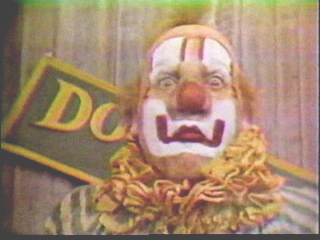
Although Clarabell had been added very early on to keep with the original circus theme, later for some reason the show shifted to a western theme, with Howdy in plaid shirt, neckerchief, and cowboy boots, and Buffalo Bob in fringed cowboy shirts.
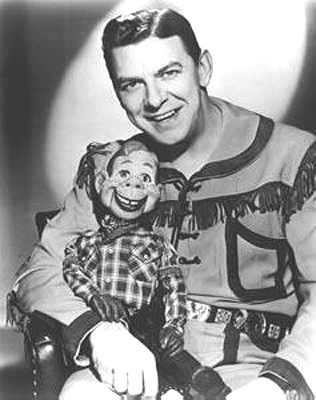
As an aside …remember that creator of the original Howdy Doody marionette? Frank Paris’s Howdy puppet may have been pretty ugly by some standards, but actually Paris wasn’t just some incompetent local dabbler in puppeteering.
When he died in 1984 at age 70, his obituary included this:
Mr. Paris, who controlled the strings of elaborate puppets modeled after such stars as Carmen Miranda and Sonja Henie, entertained audiences around the world with his combination of writing, performing and puppetry.
Mr. Paris performed in Madison Square Garden and Radio City Music Hall in New York, at the Biltmore Bowl in Los Angeles and made appearances on television with such personalities as Ed Sullivan and Milton Berle.
Paris wasn’t a “kiddy puppet” maker…he made adult-
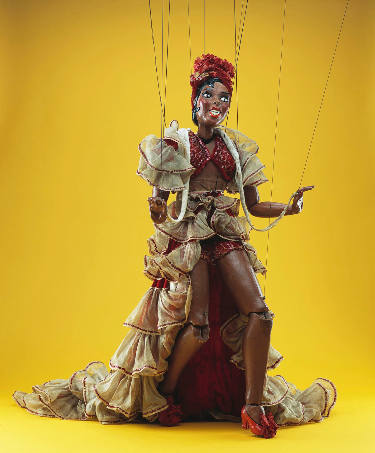

Paris was a master of mechanical motion. You can see a video clip sample of his extremely fancy 1930s puppetry here. (One section is of a marionette Fan Dancer. Don’t watch if you are offended by semi-
The Howdy Doody show was part of my childhood, since I am part of the Baby Boom generation. But I think most kids in the generation of my daughter, who was born in 1970, knew nothing of this famous woodenhead. That is, until a Happy Days episode in 1975 (set in the 1950s) featured Richie Cunningham entering a Howdy Doody look-
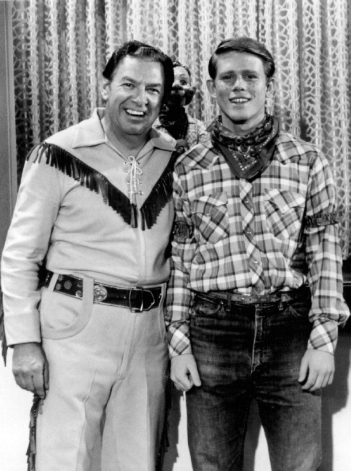
I have been surprised to finally realize that most people in my grandchildren’s generation (they are 21 and 23) had no clue that the “Woody” cowboy character in the Toy Story movies was based on Howdy Doody! To us oldsters it is ridiculously obvious. But that’s ancient history to our grandkids.
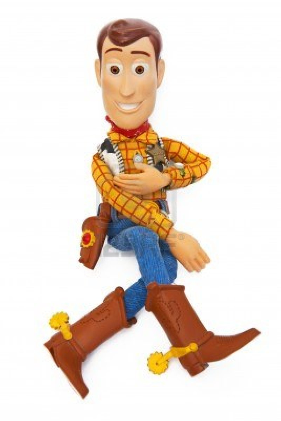
I’ve also been amazed to see how widespread vintage Howdy merchandise is now on E-
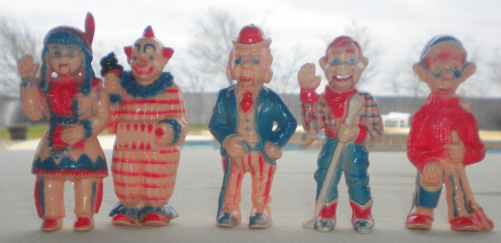
I guess I shouldn’t have been surprised that there seems to be a recent surge in the availability of Howdy memorabilia. I just read that there was a 24 page catalog in 1955 featuring nothing but Howdy merchandise, so tons of the stuff went on the market. And many of my Boomer friends tend to hoard things from their childhood. When they find out OTHER Boomers are so nostalgic for their own childhood that they are willing to pay good money to recapture just a bit of it, some of the hoarders are glad to rummage through their attics and basements to supplement their Social Security with some Ebay sales!
The original freckle-
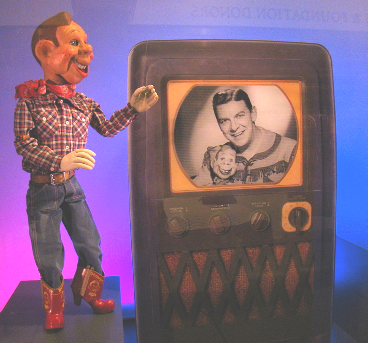
The “Double Doody” puppet, made around the time of the original “woodstic surgery” incident, resides at the Smithsonian.
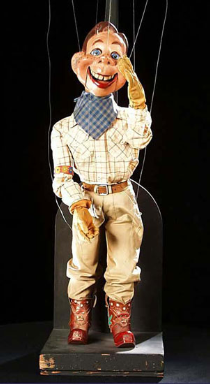
And “Photo Doody,” which had no strings and was used for publicity photo shoots and appearances, was sold to a private collector in 1997 for $113,000.
Photo Doody is one of the three original Howdy Doody 1940s marionettes. He is the Howdy figure that was used in Howdy Doody still photo sessions for the Howdy Doody Show and the publicity pictures taken with Buffalo Bob Smith. The near-
… In 1998 the Palm Beach Daily News (The Shiny Sheet), a Palm Beach Post newspaper, identified TJ Fisher as the Photo Doody high bidder. A "Howdy Doody Comes to Town" front-
TJ Fisher? You might think that sounds like some Baby Boomer fella with a hankerin’ to own a piece of his childhood.
Nope. Here’s TJ and Howdy.
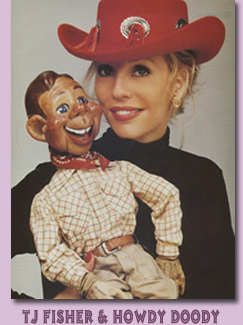
TJ is a Southern author who writes mostly about New Orleans. And the convertible she used to wine and dine Handsome Howdy? I’m pretty sure it was this one.
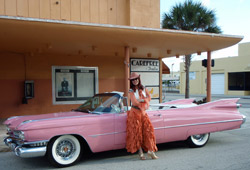
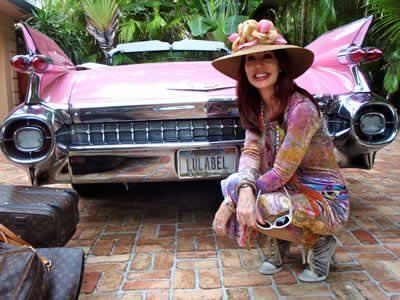
Looks like the ol’ woodstic surgery finally paid off!
Check out All Hail Howdy Doody for even more details on the show.